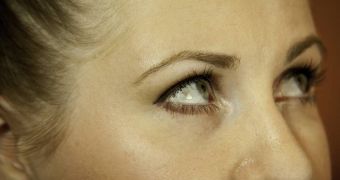A 26-year-old woman from Russia is the first person in New York to have a piece of platinum jewelry inserted in her eyeball. Kristina Kovalevskya wanted something to set her apart from the crowd, so she decided to have a heart-shaped crystal implanted into her eye.
Platinum eyeball jewelry seems to be the new piercing. It has become very popular in Europe lately, and the trend has now crossed the ocean. Eye surgeon Dr. Emil Chynn of Park Avenue Laser Vision implanted a heart-shaped jewelry on the white of Kristina's right eyeball.
Dr. Chynn is the first ophthalmologist in North America to perform this type of cosmetic surgery. He explains that the procedure, which was invented by a Dutch ophthalmologist and introduced in 2004, is safe and doesn't pose any risk to health. He also adds that it has been done hundreds of times in Europe and in Los Angeles before.
“The procedure involves making a very tiny incision in the clear covering of the eye, or skin of the eye. The platinum is then inserted. I don’t have to suture it up because it’s so small and it just closes up after three days,” Dr. Chynn explains, as cited by Black Book.
Kristina Kovalevskaya paid $3,000 (€2,159) to have the 3.5mm (0.13inch) bling placed on the white of her right eyeball.
“I’m a person who likes extremes. I want to keep it in my eye as long as possible. I like it, but I’m planning to swap it out. I really want to try a new design. Every girl wants to try something new,” the woman said.
She now has a shiny accessory in the corner of her right eye. The platinum heart has a little curve to it, to help conform to the shape of the eye. Kovalevskaya chose a heart-shaped bling because she says “I’m already a star.”
Although Dr. Chynn claims the cosmetic procedure is completely safe, the American Academy of Ophthalmology warns against it, saying that the jewelry has not been approved by the U.S. Food and Drug Administration.
“The American Academy of Ophthalmology has not identified sufficient evidence to support the safety or therapeutic value of this procedure,” representatives of the academy said in a statement in November, according to ABC News. They warn potential clients about the complications, including blindness from ocular infection, conjunctivitis, bleeding beneath the conjunctiva and perforation of the eye.

 14 DAY TRIAL //
14 DAY TRIAL //